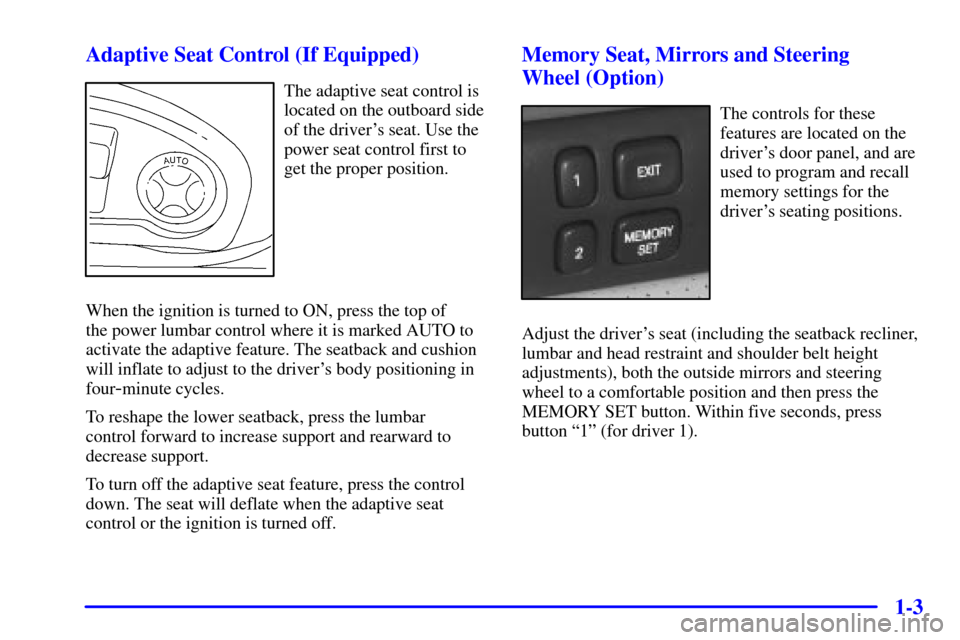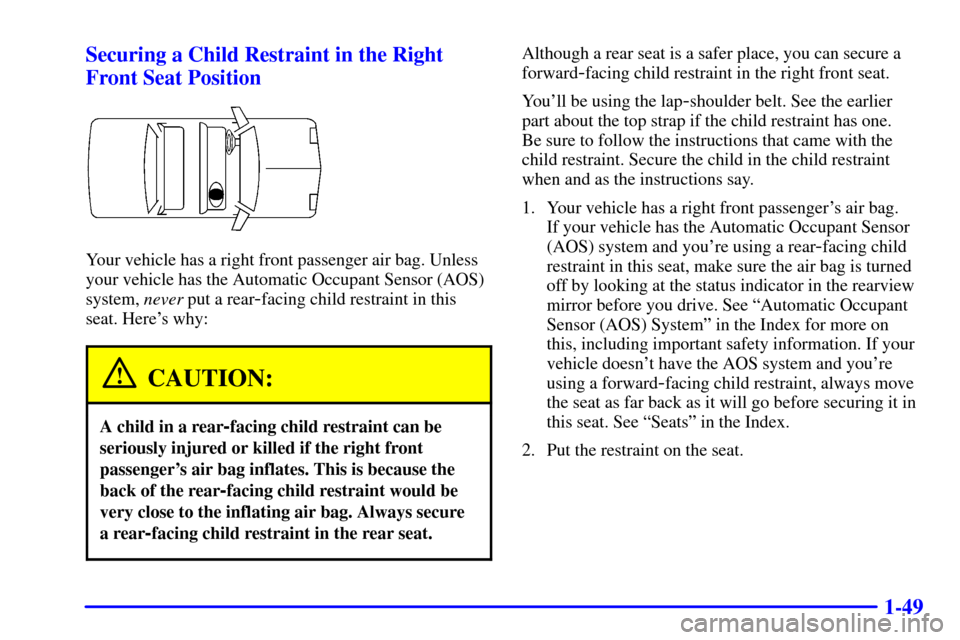Page 4 of 371
Table of Contents
Windows
Keys and Door Locks
Remote Keyless Entry System
Trunk Release
Automatic Transaxle
Parking Brake
Tilt Wheel
Turn Signal/Multifunction Lever
Windshield Wipers
Cruise Control
Exterior and Interior Lamps
MirrorsStorage Compartments
Convenience Net
Accessory Power Outlets
OnStar® System (If Equipped)
Sunroof (Option)
HomeLink® Transmitter (If Equipped)
Instrument Panel, Warning Lights and Gages
Driver Information Center (DIC)
Vehicle Programming and Personalization
Features (If Equipped)
Ultrasonic Rear Parking Assist (URPA) (Option) Seats and Seat Controls
Safety BeltsAir Bag Systems
Restraint Systems for Children
Section
1
Section
2
Seats and Restraint Systems
Features and Controls
ii
Page 15 of 371

1-3 Adaptive Seat Control (If Equipped)
The adaptive seat control is
located on the outboard side
of the driver's seat. Use the
power seat control first to
get the proper position.
When the ignition is turned to ON, press the top of
the power lumbar control where it is marked AUTO to
activate the adaptive feature. The seatback and cushion
will inflate to adjust to the driver's body positioning in
four
-minute cycles.
To reshape the lower seatback, press the lumbar
control forward to increase support and rearward to
decrease support.
To turn off the adaptive seat feature, press the control
down. The seat will deflate when the adaptive seat
control or the ignition is turned off.
Memory Seat, Mirrors and Steering
Wheel (Option)
The controls for these
features are located on the
driver's door panel, and are
used to program and recall
memory settings for the
driver's seating positions.
Adjust the driver's seat (including the seatback recliner,
lumbar and head restraint and shoulder belt height
adjustments), both the outside mirrors and steering
wheel to a comfortable position and then press the
MEMORY SET button. Within five seconds, press
button ª1º (for driver 1).
Page 16 of 371

1-4
A second mirror, seating and steering wheel position
can be programmed by repeating the above steps and
pressing button ª2º (for driver 2). Each time a memory
button is pressed, a single beep will sound. Each time
button 1 or 2 is pressed and released while the vehicle is
in PARK (P), the memory positions will be recalled.
Each time button 1 or 2 is pressed and held while the
vehicle is out of PARK (P), the memory positions will
be recalled.
To stop recall movement of the memory seat and
steering wheel at any time, press one of the power seat,
steering wheel or mirror controls.
Two personalized exit positions can be set by first
recalling the driving position (by pressing 1 or 2),
then positioning the steering wheel and seat in the
desired exit positions and then pressing and releasing
the MEMORY SET button and, within five seconds,
pressing the EXIT button. With the vehicle in PARK (P),
the exit position for either previously set driver can be
recalled by pressing the EXIT button. The mirrors,
power lumbar and power head restraint and shoulder belt
height positions will not be stored or recalled for the
exit positions.If you use the remote keyless entry transmitter to enter
your vehicle, automatic seat and mirror movement will
occur. The numbers on the back of the transmitters,
1 and 2, correspond to the numbers on the buttons on
the door panel.
When the key is placed in the ignition in OFF or when
the unlock button is pressed on the remote keyless entry
transmitter, the seats and mirrors will automatically
adjust to the programmed position.
Programming for automatic seat, steering wheel and
mirror movement is done through the Driver Information
Center (DIC). You can choose to either select or not
select automatic seat and mirror movement using the
remote keyless entry transmitter, placing your key in
the ignition, or by exiting the vehicle. For programming
information, see ªVehicle Programming and
Personalization Featuresº in the Index.
Page 42 of 371
1-30 Automatic Occupant Sensor (AOS) System
Your vehicle may have an automatic system that will turn
off the right front passenger's frontal and side impact air
bags under certain conditions. The driver's frontal and
side impact air bags are not part of the AOS system.
United States CanadaIf the rearview mirror in your vehicle has PASSENGER
AIR BAG on it, your vehicle has the AOS system.
When you turn the key to ON or START, the words ON
and OFF will come on in the rearview mirror. See
ªPASSENGER AIR BAG ON/OFF Lightº in the Index.
If your rearview mirror doesn't have the words
PASSENGER AIR BAG on it, your vehicle doesn't
have the AOS system.
The AOS system works with sensors that are part of the
right front passenger's seat. The sensors are designed
to detect the presence of an occupant on the seat and
determine if the passenger's frontal and side impact
air bags should be on or off.
Page 43 of 371
1-31
The AOS system is designed to turn off the passenger's
frontal and side impact air bags if:
�the right front passenger seat is unoccupied,
�the system detects a rear
-facing infant seat,
�the system detects a forward
-facing child restraint,
�the right front passenger seat is occupied by a
smaller person, such as a child who has outgrown
child restraints or a very small adult.
If there is a critical problem with the frontal air bag
system or the AOS system, the system is designed
to turn the air bags off. If there is a problem with the
side impact air bag system, the side impact air bag
would be off but the passenger's frontal bag would
continue to operate normally.When the AOS system has turned off the passenger's
frontal and side impact air bags, the OFF light in the
rearview mirror will stay on to remind you that the air
bags are off.
United States Canada
Page 44 of 371
1-32
The right front passenger's frontal and side impact air
bags will be turned on anytime the AOS system senses
that a person of adult size is sitting in the right front
passenger seat. When the air bags are turned on,
the ON light in the rearview mirror will stay on to
remind you that the air bags are on.
United States Canada
CAUTION:
If the air bag readiness light on the instrument
panel ever comes on, it means that something
may be wrong with the air bag system. If this
ever happens, have the vehicle serviced promptly,
because an adult
-size person sitting there may
not have the protection of the air bags. See ªAir
Bag Readiness Lightº in the Index for more on
this, including important safety information.
Aftermarket equipment, such as seat covers, can affect
how well the AOS system operates. You may not want
to use seat covers or other aftermarket equipment if your
vehicle has the AOS system.
Page 61 of 371

1-49 Securing a Child Restraint in the Right
Front Seat Position
Your vehicle has a right front passenger air bag. Unless
your vehicle has the Automatic Occupant Sensor (AOS)
system, never put a rear
-facing child restraint in this
seat. Here's why:
CAUTION:
A child in a rear-facing child restraint can be
seriously injured or killed if the right front
passenger's air bag inflates. This is because the
back of the rear
-facing child restraint would be
very close to the inflating air bag. Always secure
a rear
-facing child restraint in the rear seat.
Although a rear seat is a safer place, you can secure a
forward
-facing child restraint in the right front seat.
You'll be using the lap
-shoulder belt. See the earlier
part about the top strap if the child restraint has one.
Be sure to follow the instructions that came with the
child restraint. Secure the child in the child restraint
when and as the instructions say.
1. Your vehicle has a right front passenger's air bag.
If your vehicle has the Automatic Occupant Sensor
(AOS) system and you're using a rear
-facing child
restraint in this seat, make sure the air bag is turned
off by looking at the status indicator in the rearview
mirror before you drive. See ªAutomatic Occupant
Sensor (AOS) Systemº in the Index for more on
this, including important safety information. If your
vehicle doesn't have the AOS system and you're
using a forward
-facing child restraint, always move
the seat as far back as it will go before securing it in
this seat. See ªSeatsº in the Index.
2. Put the restraint on the seat.
Page 63 of 371
1-51
6. To tighten the belt, feed the lap belt back into the
retractor while you push down on the child restraint.
You may find it helpful to use your knee to push
down on the child restraint as you tighten the belt.7. Push and pull the child restraint in different
directions to be sure it is secure.
8. If your vehicle has the Automatic Occupant Sensor
(AOS) system, before you begin to drive, check to
be sure the right front passenger's frontal and side
impact air bags are off if you're using a rear
-facing
infant restraint. If the air bags are off, the word OFF
will appear in the rearview mirror.
If the word ON appears in the rearview mirror, the
frontal and side impact air bags have not been turned
off. If this ever happens, unbuckle the safety belt and
perform the steps to install the rear
-facing restraint
again. If the air bags still don't turn off, install the
infant restraint in a rear seat position and have your
vehicle serviced as soon as possible.